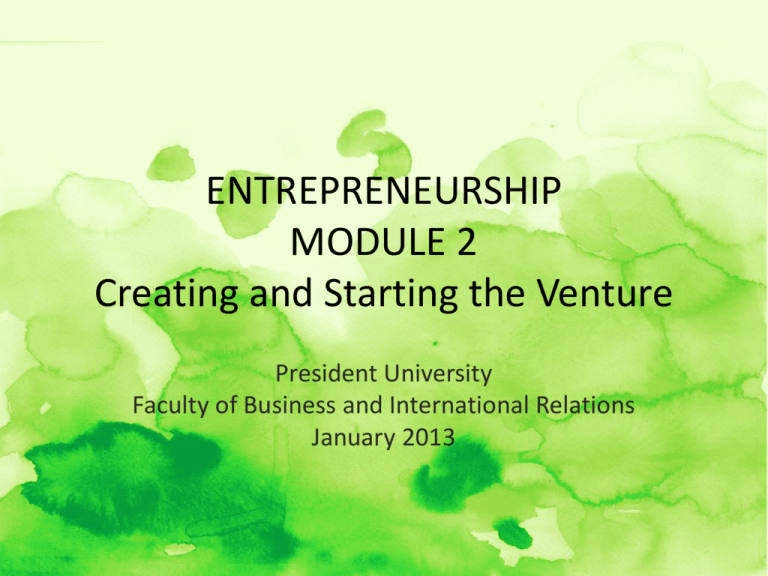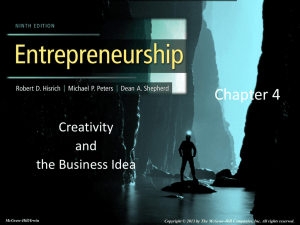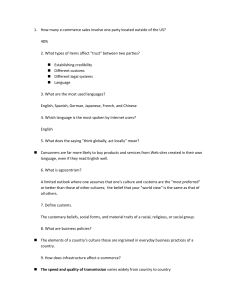
ENTREPRENEURSHIP
MODULE 2
Creating and Starting the Venture
President University
Faculty of Business and International Relations
January 2013
Learning Objectives
• To identify various sources of ideas for new venture
• To know the methods available for generating new
venture ideas
• To discuss creativity and the techniques for creative
problem solving
• To discuss the aspects of the product planning and
development process
Chapter 4
Creativity
and
the Business Idea
Hisrich
Peters
McGraw-Hill/Irwin
Copyright © 2010 by The McGraw-Hill Companies, Inc. All rights reserved.
Shepherd
Trends
• The start of a trend that lasts for a
considerable period of time provides one of
the greatest opportunities for starting a new
venture.
• Trends that will provide opportunities include:
green trend, clean-energy trend, organicorientation trend, economic trend, social
trend, health trend, and Web trend.
Sources of New Ideas
• Consumers
– Informally monitor potential ideas and needs.
– Formally arrange for consumers to express their
opinions.
• Existing Products and Services
– Analysis uncovers ways to improve offerings that
may result in a new product or service.
• Distribution Channels
– Channel members can help suggest and market new
products.
Sources of New Ideas
(cont.)
• Federal Government
– Files of the Patent Office can suggest new product
possibilities.
– New product ideas can come in response to
government regulations.
• Research and Development
– A formal endeavor connected with one’s current
employment.
– An informal lab in a basement or garage.
Methods of Generating New Ideas
• Focus Groups
– A moderator leads a group of 8 to 14 participants
through an open, in-depth discussion in a directive
or nondirective manner.
– An excellent method for generating and screening
ideas and concepts.
Methods of Generating New Ideas
(cont.)
• Brainstorming
– Allows people to be stimulated to greater creativity.
– Good ideas emerge when the brainstorming effort
focuses on a specific product or market area.
– Rules of brainstorming:
•
•
•
•
No criticism.
Freewheeling is encouraged.
Quantity of ideas is desired.
Combinations and improvements of ideas are encouraged.
Methods of Generating New Ideas
(cont.)
• Brainwriting
– A form of written brainstorming.
– Participants write their ideas on special forms or
cards that circulate within the group.
• Problem Inventory Analysis
– Consumers are provided with a list of problems and
are asked to identify products that have those
problems.
– Results must be carefully evaluated as they may not
actually reflect a new business opportunity.
Creative Problem Solving
• Creativity tends to decline with age, education,
lack of use, and bureaucracy.
• Latent creative potential can be stifled by
perceptual, cultural, emotional, and
organizational factors.
• Creativity can be unlocked by using any of the
creative problem-solving techniques.
Creative Problem Solving
(cont.)
• Brainstorming
– Session starts with a problem statement.
– No group member should be an expert in the field
of the problem.
– All ideas must be recorded.
• Reverse Brainstorming
– A group method that focuses on the negative
aspects of a product, service, or idea as well as ways
to overcome these problems.
– Care must be taken to maintain group morale.
Creative Problem Solving
(cont.)
• Gordon Method
– Method for developing new ideas when the individuals
are unaware of the problem.
– Solutions are not clouded by preconceived ideas and
behavioral patterns.
• Checklist Method
– Developing a new idea through a list of related issues.
• Free Association
– Developing a new idea through a chain of word
associations.
Creative Problem Solving
(cont.)
• Forced Relationships
– Developing a new idea by looking at product
combinations.
– A five step process which focuses on generating
ideas from relationship patterns between
elements of a problem.
• Collective Notebook Method
– Developing a new idea by group members
regularly recording ideas.
Creative Problem Solving
(cont.)
• Attribute Listing
– Developing a new idea by looking at the positives
and negatives.
• Big-Dream Approach
– Developing a new idea by thinking without
constraints.
• Parameter Analysis
– Developing a new idea by focusing on parameter
identification and creative synthesis.
Figure 4.1 - Illustration of Parameter
Analysis
Innovation
• Types of Innovation
– Breakthrough
• Fewest number of innovations.
• Establishes the platform on which future innovations in an
area are developed.
• Should be protected by patents, trademarks, and copyrights.
– Technological
• Occurs more frequently; not at the same level of breakthrough
inventions.
• Offers advancements in the product/market area.
• Needs to be protected.
Innovation
(cont.)
– Ordinary
• Occurs most frequently.
• Extends a technological innovation into a better product
or service or one that has a different market appeal.
• Usually come from market analysis and pull, not
technology push.
Innovation
(cont.)
• Defining a New Innovation (Product or Service)
– Newness can be:
• In the consumer concept.
• A change in the package or container.
• Slight changes or modifications in the appearance of the
product. (Industrial market)
– Companies also add products to their product line
that are already marketed by other companies;
products are new to the manufacturer but not the
consumer.
Innovation
(cont.)
• Classification of New Products
– Consumer’s Viewpoint
• The continuum proposed by Thomas Robertson is based
on the disrupting influence that use of the product has
on established consumption patterns.
– Continuous innovations.
– Dynamically continuous.
– Discontinuous innovations.
• This approach is consistent with the marketing
philosophy that “satisfaction of consumer needs” is
fundamental to a venture’s existence.
Figure 4.3 - Continuum for Classifying
New Products
Innovation
(cont.)
– Firm’s Viewpoint
• Distinction can be made between new products and new
markets.
• Situations with a new technology and a new market are
the most complicated and pose the highest degree of
risk.
Figure 4.4 - New Product Classification
System
Figure 4.5 - A Model of the
Opportunity Recognition Process
Product Planning and Development
Process
• Establishing Evaluation Criteria
– Criteria should be established at each stage of the
product planning and development process.
– It should be all-inclusive and quantitative in nature.
– Criteria should evaluate the idea in terms of:
•
•
•
•
•
Market opportunity.
Competition.
Marketing system.
Financial factors.
Production factors.
Figure 4.6 - The Product Planning and
Development Process
Product Planning and Development
Process (cont.)
• Idea Stage
– Promising ideas should be identified and impractical
ones eliminated.
– Evaluation method – Systematic market evaluation
checklist.
– Determine the need for the new idea as well as its
value to the company.
• Concept Stage
– Refined idea is tested to determine consumer
acceptance which can be measured through the
conversational interview method.
Product Planning and Development
Process (cont.)
• Product Development Stage
– Consumer reaction to the product/service is
determined.
– A consumer panel is given a product sample and
preference is determined through methods such
as multiple brand comparisons, risk analysis, etc.
• Test Marketing Stage
– Increases certainty of successful
commercialization.
– Actual sales reflect consumer acceptance.
E-commerce and Business Start-up
• E-commerce offers entrepreneurs an
opportunity to be creative and innovative.
• Factors that facilitate high-growth in electronic
commerce:
– Widespread use of personal computers.
– Adoption of intranets in companies.
– Acceptance of the Internet as a business
communications platform.
– Faster and more secure systems.
E-commerce and Business Start-up
(cont.)
• Using E-Commerce Creatively
– Entrepreneurs have to decide whether to:
• Run Internet operations within the company.
• Outsource these operations to Internet specialists.
• Use e-commerce packages provided by software
companies.
– The integration of front-end and back-end
operations represents the greatest challenge for
doing Internet business.
E-commerce and Business Start-up
(cont.)
• Web Sites
– Ease of use.
– Structure and organization of information.
– Search capability.
– E-mail response system.
– Speed.
– Compatibility with different browsers and
platforms.
E-commerce and Business Start-up
(cont.)
• Tracking Customer Information
– Electronic databases track the activity of the
industry, segment, and company.
– It supports personal marketing targeted at
individual clients.
– Care must be taken to follow the laws protecting
the privacy of individuals.
E-commerce and Business Start-up
(cont.)
• Doing E-Commerce as an Entrepreneurial
Company
– Products should be delivered economically and
conveniently.
– Products need to interest a wide market; company
must be ready to ship the product outside its own
geographical location.
– Online operations should bring significant cost
reductions.
– Company must be able to economically draw
customers to its Web site.

![[02]. Creativity and the Business Idea](http://s2.studylib.net/store/data/005544885_1-db12aa0d8b1f4f1b18550951d627f993-300x300.png)








